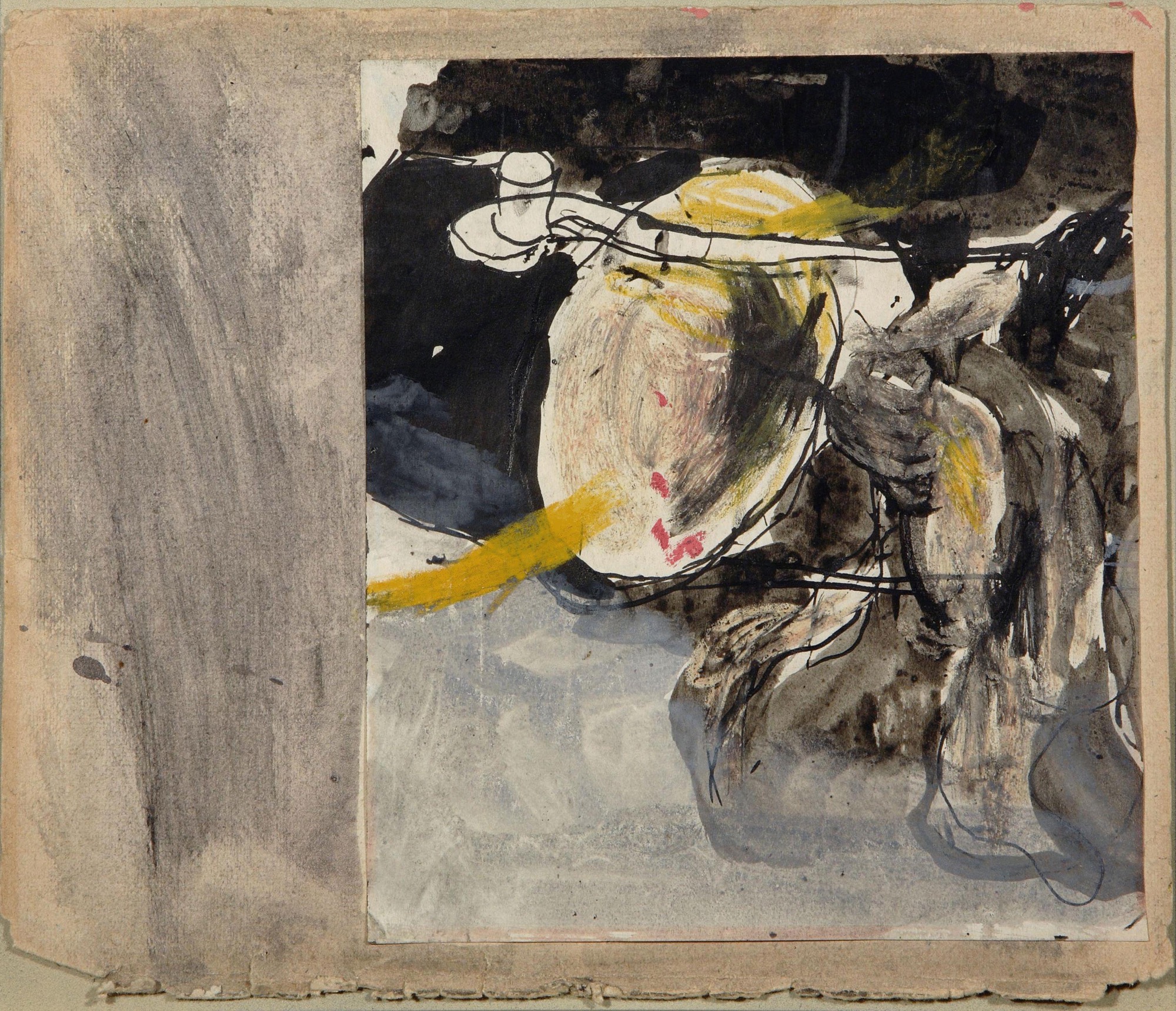Ideas and Studies for Open Hearth Furnace, c1941
10765
GRAHAM SUTHERLAND O.M. (British, 1903-1980)
Ideas and Studies for Open Hearth Furnace
Inscribed 'Ideas and Studies/for Open Hearth Furnace/Subject' & sketch verso
Black ink, watercolour, pastel and bodycolour
EXHIBITED: Goldmark Gallery, Graham Sutherland Wartime Paintings, December 2002, no. 8, as 'Mouth of Hot Metal Container'.
RELATED TO : The Wartime Drawings (Tassi) :
96 Flames leaping from furnace 1941.
99 Pouring moulten steel into furnace 1941.
120 Iron & container, Cardiff 1942
121 Mouth of hot metal container, 1942. City Art Gallery Manchester
At the age of 16 Sutherland was employed as an apprentice at the Midland Railway Locomotive Works in Derby. Here, he trained as an engineer and he gained an understanding of the machinery, but displayed no aptitude for mathematics. He experienced what it took to beat a rivet, with both power and precision, into the required shape for an engine. After a year's employment, which he later credited with stimulating his lasting fascination with machinery, he enrolled at art school. ' When he later painted furnaces in the steel foundaries he was reveling in scenes worthy of Dante's inferno and paying tribute to the endurance and practicality of the human beings who have this primary blaze under control.' Alexandra Harris
Sutherland was one of the first artists 'recruited' by Kenneth Clark into the War Artists Advisory Committee (WAAC) scheme, and like his contemporaries Henry Moore and John Piper, he initially felt slightly uncertain as to how he might apply his own vision to such a programme. However, in the devastated streets and warehouses of the East End of London, he found the sources for a powerful body of work, full of foreboding.
In the Autumn of 1941, Sutherland was sent by the War Artists' Advisory Committee to record steel and ammunition works in Cardiff. Malcolm Yorke comments on Sutherland's series of steelworks, 'Now all his sunset colours could be deployed again in the flow of molton iron, flames belching from furnace doors, glowing crusts of slag and the plop and seeth of boiling metal' (see M. Yorke, Nine Neo-Romantic Artists and Their Times, London, 1988, pp. 125-126).
The combination of the industrial architecture and the almost alchemical processes involved gave him ample subject matter to create images that are at once factual and fantastical. The technical processes in steel manufacture clearly fascinated Sutherland, and he draws this into the images that he produced. Whilst ostensibly dealing with a depiction of an industrial process essential to the war effort, Sutherland transforms these scenes, the huge furnaces and crucibles taking on a life of their own. Huge tongues of flame leap from the crucibles of molten metal and the hot yellows, pinks and reds add an infernal glow to the whole. The human is reduced to a mere cipher.
Sutherland comments on his furnace work of this period: 'The conception of the idea of stress, both physical and mental, and how forms can be modified by emotion had been, even before the war, much in my mind. It was crystallized and strengthened by my understanding of Picasso's studies for Guernica. Faces become distorted by tears and mouths open in fear. Even a hand supporting a head creates distortion, as does the placing of food in the mouth. I had seen aspects of this idea in certain kinds of destruction. So did I too in the steelworks. As the hand feeds the mouth so did the long scoops which plunged into the furnace openings feed them, and the metal containers pouring molten iron into ladles had great encrusted mouths'
Sheet Height 24 cm., 9 ½ in., Length 29 cm., 11 ½ in.,
In a stained oak frame. Height 38.5 cm., 1 ft., 3 in., Length 43 cm. 1ft. 5 ¾ in.
Paintings in Museums and Public Art Galleries : UK
• British Council Art Collection
• Fitzwilliam Museum, Cambridge, UK
• National Galleries of Scotland, Edinburgh
• Royal Academy of Arts Collection, London, UK
• The Royal Collection, London, UK
• National Museum Wales, Cardiff
• Cheltenham Art Gallery and Museum, UK
• Courtauld Institute of Art, London, UK
• Hunterian Museum and Art Gallery, University of Glasgow, Scotland
• Manchester City Art Gallery, UK
• Minneapolis Institute of Arts, Minnesota
• National Portrait Gallery, London, UK
• Norwich Museums, England
• Tate Gallery, London, UK
• The Faringdon Collection at Buscot Park, Oxfordshire, UK
• The Hepworth Wakefield, England
• Tyne & Wear Museums, England
• Victoria and Albert Museum Catalogue, London, UK
• Whitworth Art Gallery, Manchester, UK
Paintings in Museums and Public Art Galleries : Worldwide:
• Pomona College Museum of Art, California
• North Carolina Museum of Art, Raleigh
• Institute of Chicago
• Dallas Museum of Art, Texas
• Harvard University Art Museums, Massachusetts
• Hirshhorn Museum and Sculpture Garden, Washington D.C.
• Museum of Modern Art, New York City
• National Gallery of Canada, Ottawa
• Peggy Guggenheim Collection, Venice
• Art Gallery of New South Wales, Sydney, Australia
• Beaverbrook Art Gallery, New Brunswick
• Christchurch Art Gallery / Te Puna O Waiwhetu, New Zealand
20th Century
1941
British
Commemorative

















